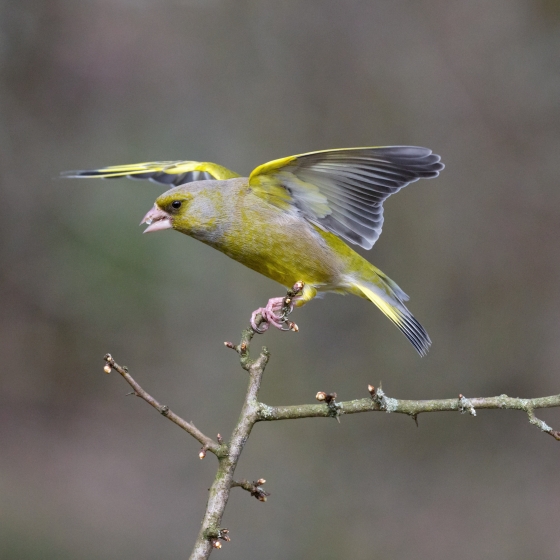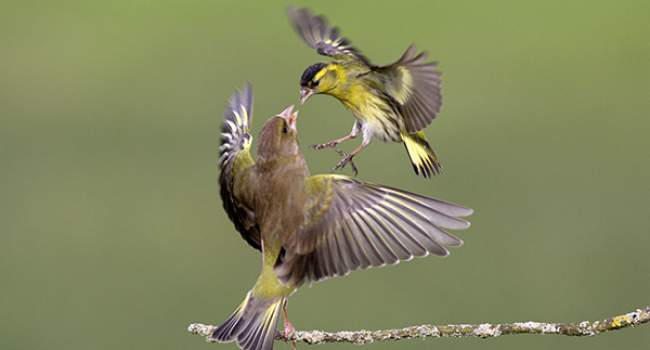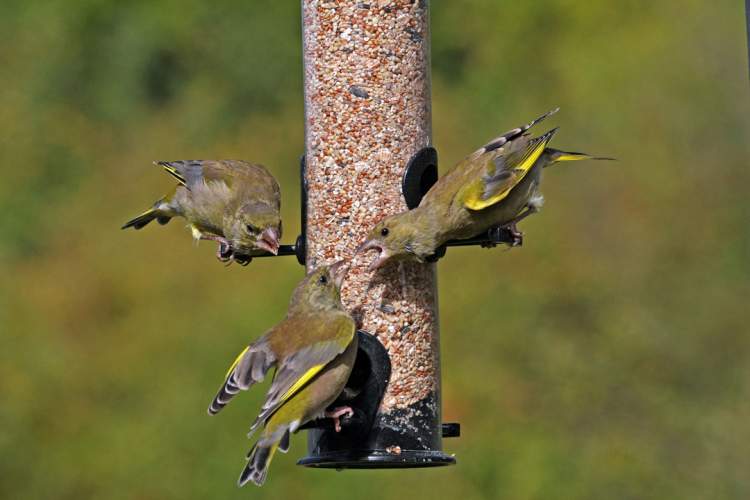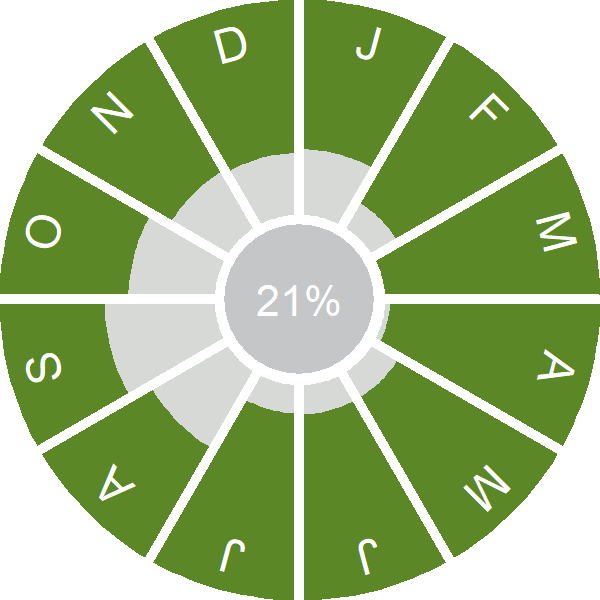Greenfinch
Chloris chloris (Linnaeus, 1758)
GR
 GREFI
GREFI  16490
16490

Family: Passeriformes > Fringillidae

This stocky finch can be found throughout in Britain & Ireland at all times of the year, except on the highest peaks.
The Greenfinch has a twittering song, which features a distinct drawn-out wheeze. It is a bold species and can enter into squabbles with other birds at garden feeders. It is also found in open woodland and farmland. Males have distinctive green plumage, with yellow in the wing and tail. Females and juveniles are duller.
The Greenfinch has undergone a major population decline in the UK since the mid-2000s, due to the disease Trichomonosis. It was added to the UK Red List in 2021. In the winter, Greenfinch numbers are supplemented by birds migrating from Fennoscandia.
Exploring the trends for Greenfinch
Our Trends Explorer will also give you the latest insight into how the UK's Greenfinch population is changing.
trends explorerIdentification
Greenfinch identification is usually straightforward. The following article may help when identifying Greenfinch.
Identifying Green finches in your garden

Not all green finches are Greenfinches. There are a number of green and yellow finches that visit garden feeders, some common, some much more rare. Let us help you to discover the identity of an unfamiliar visitor - is it a Serin - or is it one of the more likely culprits?
SONGS AND CALLS
Listen to example recordings of the main vocalisations of Greenfinch, provided by xeno-canto contributors.
Begging call
Call
Song
Develop your bird ID skills with our training courses
Our interactive online courses are a great way to develop your bird identification skills, whether you're new to the hobby or a competent birder looking to hone your abilities.
Browse training coursesStatus and Trends
Population size and trends and patterns of distribution based on BTO surveys and atlases with data collected by BTO volunteers.
CONSERVATION STATUS
This species can be found on the following statutory and conservation listings and schedules.
POPULATION CHANGE
Greenfinch abundance fluctuated somewhat up to the mid 1990s, but there was little change in either survival or breeding performance during this period (Siriwardena et al. 1998b, 2000b). More recent CBC/BBS data indicate population increases widely across the UK, followed by a sudden sharp fall induced by a widespread and severe outbreak of trichomonosis disease. Although Greenfinch is currently still green listed in the UK, based on the trend at the time of the last review (Eaton et al. 2015), the current decline would raise red listing and caused it to be rated as 'Endangered' in a recent assessment of UK species which followed IUCN criteria and categories (Stanbury et al. 2017).
The BBS map of change in relative density between 1994-96 and 2007-09 indicates that increases over that period, strongest in East Anglia and in western Britain, contrasted with decreases in eastern Northern Ireland, northeastern Scotland and central southern England. The subsequent, disease-related decrease is ongoing in all parts of the UK. Numbers across Europe have been broadly stable since 1980, with early increases being followed by a decline starting in the 1990s (PECBMS: PECBMS 2020a>).
| UK breeding population |
-69% decrease (1967–2022) 
|
Exploring the trends for Greenfinch
Our Trends Explorer will also give you the latest insight into how the UK's Greenfinch population is changing.
trends explorerDISTRIBUTION
Greenfinches are widely distributed in winter and the breeding season, perhaps showing especially strong associations with villages and towns across Britain & Ireland. Like the Goldfinch, its only significant range gaps are in the higher parts of northern Scotland. Highest densities are found on lower ground, mainly in south and southeast England, eastern Scotland and in pockets throughout Ireland.
Occupied 10-km squares in UK
| No. occupied in breeding season | 2718 |
| % occupied in breeding season | 90 |
| No. occupied in winter | 2677 |
| % occupied in winter | 89 |
European Distribution Map
European Breeding Bird Atlas 2
Breeding Season Habitats
| Most frequent in |
Villages 
|
| Also common in | Towns |
Relative frequency by habitat
Relative occurrence in different habitat types during the breeding season.

DISTRIBUTION CHANGE
Since the 1981–84 Winter Atlas the range has increased by 18%, involving infilling in western Ireland and parts of Wales and northern England, and a more continuous expansion around the coastal-upland fringe in northwest Scotland.
Change in occupied 10-km squares in the UK
| % change in range in breeding season (1968–72 to 2008–11) | +6.2% |
| % change in range in winter (1981–84 to 2007–11) | +16% |
SEASONALITY
Greenfinch is recorded throughout the year on up to 30% of complete lists.

Movement
Information about movement and migration based on online bird portals (e.g. BirdTrack), Ringing schemes and tracking studies.
RINGING RECOVERIES
View a summary of recoveries in the Online Ringing Report.
Foreign locations of birds ringed or recovered in Britain & Ireland

Biology
Lifecycle and body size information about Greenfinch, including statistics on nesting, eggs and lifespan based on BTO ringing and nest recording data.
PRODUCTIVITY & NESTING
Exploring the trends for Greenfinch
Our Trends Explorer will also give you the latest insight into how the UK's Greenfinch population is changing.
trends explorerSURVIVAL & LONGEVITY
View number ringed each year in the Online Ringing Report
Exploring the trends for Greenfinch
Our Trends Explorer will also give you the latest insight into how the UK's Greenfinch population is changing.
trends explorerBIOMETRICS
Wing Length 
|
Adults | 87.7±4.2 | Range 84–91mm, N=118743 |
| Juveniles | 87.5±2.2 | Range 84-91mm, N=72205 | |
| Males | 88.8±4.1 | Range 86–92mm, N=65831 | |
| Females | 86.3±4 | Range 83–89mm, N=52565 |
Body Weight 
|
Adults | 27.7±4.1 | Range 24.7–30.9g, N=96718 |
| Juveniles | 27.7±2.9 | Range 25.0–30.7g, N=55415 | |
| Males | 27.5±3.6 | Range 24.6–30.6g, N=53386 | |
| Females | 27.8±4.5 | Range 24.9–31.1g, N=43027 |
Feather measurements and photos on featherbase 
CODES & CLASSIFICATION
Ring size 
|
B |
Field Codes 
|
2-letter: GR | 5-letter code: GREFI | Euring: 16490 |
For information in another language (where available) click on a linked name
Research
Interpretation and scientific publications about Greenfinch from BTO scientists.
CAUSES AND SOLUTIONS
Causes of change
The rapid decline since 2005 has been caused by a severe outbreak of trichomonosis.
Further information on causes of change
The sudden sharp fall that began in 2005 was induced by a widespread and severe outbreak of trichomonosis, a disease which affects the upper digestive tract (Robinson et al. 2010b, Lawson et al. 2012b, 2018). Integrated population modelling shows that changes in survival have indeed been the strongest contributor to annual population change (Robinson et al. 2014).
Productivity data show minor decreases in clutch and brood sizes, but no change in the number of fledglings per breeding attempt. The trend towards earlier laying may be explained by recent climate change (Crick & Sparks 1999).
Information about conservation actions
The recent population downturn has been directly linked to the spread of trichomonosis (Lawson et al. 2014), and hence hygiene precautions are important in gardens where food and water is being provided, and stopping feeding should be considered if birds with the disease are observed (https://www.bto.org/our-science/projects/gbw/gardens-wildlife/garden-birds/disease/trichomonosis). The rate of decline has not yet slowed down and it is unclear whether improved garden hygiene will halt the decline.
As for Chaffinch, there have been no conservation concerns about this species until recently; hence there are no specific conservation actions relating to this species. However, assuming some birds are resistant to trichomonosis, actions and policies aimed at helping other farmland species are also likely to benefit Geenfinches and may enable numbers to recover in the future. These would include actions aimed at increasing food availability over winter (e.g. overwinter stubbles, wild bird seed or cover mixtures, set-aside, buffer strips or uncultivated margins) and those aimed at improving breeding habitat and food availability during the breeding season (e.g. management of hedgerows and reducing pesticide and herbicide use).
PUBLICATIONS (2)

Habitat-use influences severe disease-mediated population declines in two of the most common garden bird species in Great Britain
Is there a garden feeding link to finch decline?

Health hazards to wild birds and risk factors associated with anthropogenic food provisioning
The health hazards to wild birds associated with garden feeding.
The provision of supplementary food for wild birds at garden feeding stations is a widespread practice in the UK. These additional resources have been shown, through research, to be of benefit to wild birds, but there is still a great deal that we do not know about the wider implications of such provisioning. Wherever individual birds congregate, the risk of disease transmission is increased, and the high densities of birds often seen at garden feeding stations might contribute to the emergence and spread of infectious diseases.
Links to more studies from ConservationEvidence.com
- Habitat use by seed-eating birds: a scale-dependent approach
- Grassland bird use of riparian filter strips in southeast Iowa
- The effect of the spatial distribution of winter seed food resources on their use by farmland birds
Read more studies about Greenfinch on Conservation Evidence >
Would you like to search for another species?













Share this page